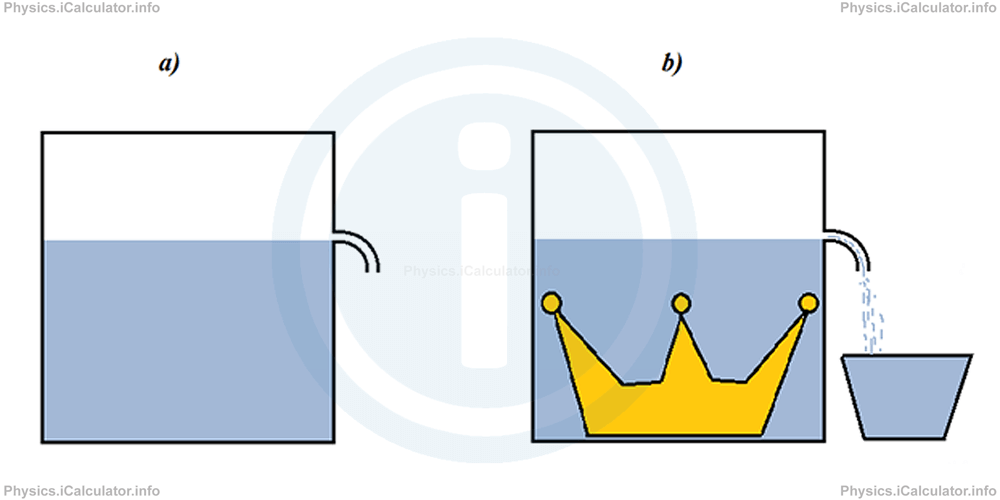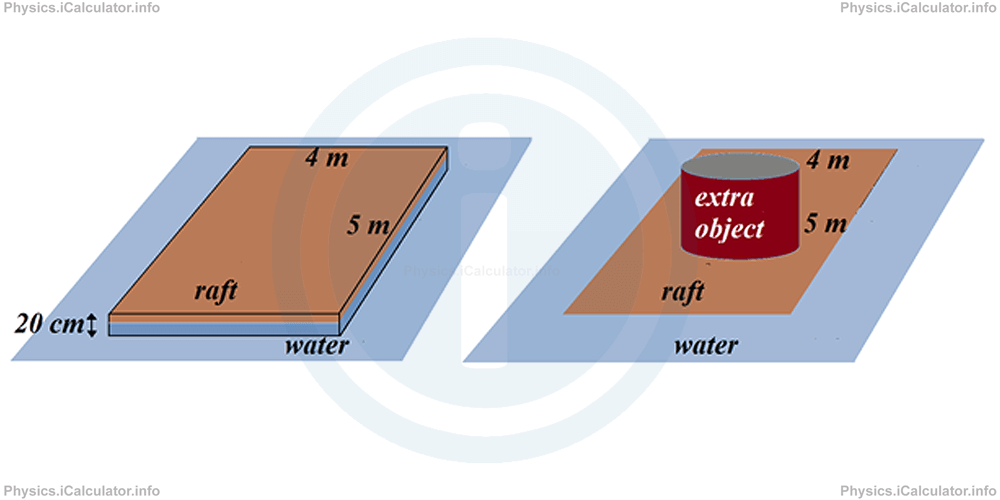Menu
Physics Lesson 9.5.3 - Archimedes' Principle
Please provide a rating, it takes seconds and helps us to keep this resource free for all to use
Welcome to our Physics lesson on Archimedes' Principle, this is the third lesson of our suite of physics lessons covering the topic of Buoyancy. Archimedes' Principle, you can find links to the other lessons within this tutorial and access additional physics learning resources below this lesson.
Archimedes' Principle
Buoyancy as a phenomenon, was first discussed and explained by the famous ancient Greek scientist Archimedes, who was able to calculate the density of an irregular object (the famous crown donated to the King by a jeweller). Thus, by measuring the volume of the displaced water, he calculated indirectly the volume of the immersed object (the crown). Then, he used the equation of density (density = mass / volume) to find whether the donated crown was made of pure gold or not (the density of gold was already known at that time).

In the first figure, water is poured in the container up to the hose level. After putting the object (the crown) inside the container, Archimedes used a bucket to collect the spilled water due to the rise in water level. (It is known that two things cannot occupy the same space at the same time. As a result, the water level rises up when the crown is placed inside the vessel because its place now is occupied by the crown). Then he used the procedure mentioned above to calculate the crown density.
However, the calculation of crown density, i.e. the calculation of irregular objects density was not Archimedes' major achievement in this experiment. He accidentally discovered that:
"The buoyant force acting on an object immersed in a liquid is numerically equal to the weight of the displaced liquid."
The above statement is known as Archimedes Principle" and it is one of the founding principles of Hydrostatics.
Mathematically, we can write the Archimedes principle as
Given that
Archimedes managed to obtain the formula of buoyant force we discussed earlier, because
Fb = mdisplaced liquid × g
= ρliquid × Vdisplaced liquid × g
which is the same formula we found earlier for the buoyant force because
Example 2
How many m3 of water spill out of a bathtub when a 80 kg man enters in it, if the bathtub initially was filled to the brim with water? Take the density of human body equal to that of water, i.e. 1000 kg/m3. Also, take the gravity g ≈ 10 m/s2.
Solution 2
From Archimedes' Principle we have
Here, the buoyant force Fb is equal to the man's weight as both the man and water have the same density. Thus,
= mman × g
= 80 kg × 10 m/s2
= 800 N
From the new equation of buoyant force (based on Archimedes' Principle), we have
Therefore,
= 800 N/1000 kg/m3 × 10 m/s2
= 0.08 m3
= 80 dm3
= 80 L
Archimedes' Principle is very important in daily life as its applications include a wide range of situation, where the most notorious is the ships construction. Thus, we can use Archimedes' Principle to calculate how much weight a boat or ship can hold without sinking. Let's see an example in this regard.
Example 3
A rectangular raft of dimensions 5 m × 4 m × 20 cm is made of wood (density of wood is 600 kg/m3).
- What is the maximum load (in kilograms) the raft can hold if the load is very precious and it must be prevented from getting wet?
- What part of the raft is initially immersed in water?

Solution 3
a In the first figure (before putting the extra object on it), the raft is floating while in the second figure (after putting the extra object on the raft), it is at limits of floating and completely immersed. The equation for the first figure is
and for the second figure, it is
From the first equation, we obtain for the initial buoyant force cause by water
= ρwood × Vraft × g
= 600 × (5 × 4 × 0.2) × 10
= 24 000 N
When the raft is completely immersed due to the downward push of the extra object (Vimmersed part = Vtotal), we have for the new buoyant force caused by the water:
= ρwater × Vtotal × g
= 1000 × (5 × 4 × 0.2) × 10
= 40 000 N
The weight of the extra object can be obtained by subtracting the two buoyant forces found above, as they represent the total weight of the system without and with load respectively. Thus,
= 40 000 N - 24 000 N
= 16 000 N
Hence, the maximum mass of the extra load the raft can hold is
= 16 000 N/10 m/s2
= 1600 kg
b The part of volume initially immersed in water is obtained by dividing the volume that was initially immersed by the total volume of the raft. Thus,
The initially immersed volume can be obtained by the formula of buoyant force, i.e.
Thus,
= 24 000/1000 × 10
= 2.4 m3
The raft's total volume is calculated by multiplying its dimensions provided in the clues. Thus,
= 4 m3
Hence, the part of the raft that was initially immersed in water expressed in percentage is
= 60%
Remark! Besides the ratio of volumes found above, the immersed part of the object can be found through two other ratios as well.
1 The ratio of buoyant forces, i.e.
= 24 000 N/40 000 N × 100%
= 60%
and
2 The ratio of densities (of object and of liquid respectively), i.e.
= 600 kg/m3/1000 kg/m3 × 100%
= 60%
You have reached the end of Physics lesson 9.5.3 Archimedes' Principle. There are 4 lessons in this physics tutorial covering Buoyancy. Archimedes' Principle, you can access all the lessons from this tutorial below.
More Buoyancy. Archimedes' Principle Lessons and Learning Resources
Whats next?
Enjoy the "Archimedes' Principle" physics lesson? People who liked the "Buoyancy. Archimedes' Principle lesson found the following resources useful:
- Archimedes Feedback. Helps other - Leave a rating for this archimedes (see below)
- Density and Pressure Physics tutorial: Buoyancy. Archimedes' Principle. Read the Buoyancy. Archimedes' Principle physics tutorial and build your physics knowledge of Density and Pressure
- Density and Pressure Revision Notes: Buoyancy. Archimedes' Principle. Print the notes so you can revise the key points covered in the physics tutorial for Buoyancy. Archimedes' Principle
- Density and Pressure Practice Questions: Buoyancy. Archimedes' Principle. Test and improve your knowledge of Buoyancy. Archimedes' Principle with example questins and answers
- Check your calculations for Density and Pressure questions with our excellent Density and Pressure calculators which contain full equations and calculations clearly displayed line by line. See the Density and Pressure Calculators by iCalculator™ below.
- Continuing learning density and pressure - read our next physics tutorial: Bernoulli Equation
Help others Learning Physics just like you
Please provide a rating, it takes seconds and helps us to keep this resource free for all to use
We hope you found this Physics lesson "Buoyancy. Archimedes' Principle" useful. If you did it would be great if you could spare the time to rate this physics lesson (simply click on the number of stars that match your assessment of this physics learning aide) and/or share on social media, this helps us identify popular tutorials and calculators and expand our free learning resources to support our users around the world have free access to expand their knowledge of physics and other disciplines.